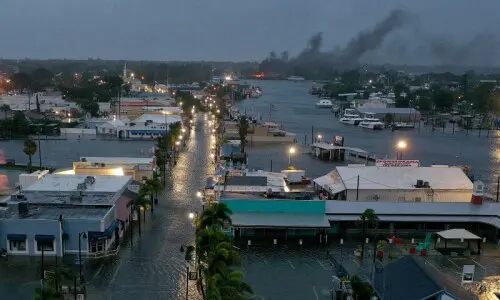Hurricane Idalia ploughed into Florida’s Big Bend region on Wednesday as an “extremely dan-gerous” Category 3 storm that forced millions of United States’ residents to evacuate or hunker down in anticipation of a life-threatening surge of tidal waters.
Drawing strength from the Gulf of Mexico’s warm waters, Idalia unleashed destructive winds and torrential downpours that were forecast to cause coastal flooding up to 16 feet deep along the state’s Gulf Coast.
Idalia came ashore at 7:45am EDT (1145 GMT) at Keaton Beach, an ocean-front community of 13,000 people in Taylor County about 75 miles southeast of Tallahassee, the state capital. The town lies in the centre of the Big Bend region, where the state’s northern panhandle curves into the Florida Peninsula.
“It’s just ripping through Taylor County now. Hope all is safe,” County Commissioner Jamie English told Reuters. “Winds gusting. Terrible power outages all over. Debris flying everywhere.”
There were few early reports of flooding available. By midmorning, a National Oceanic and Atmospheric Administration weather monitoring station in Steinhatchee, 20 miles south of Keaton, showed waters reaching 8 feet, well above the 6-foot flood stage. Other monitoring stations to the south in the more densely populated Tampa area showed water levels at a “minor flooding” stage at 10am EST.
All night, howling winds and seemingly endless sheets of rain pelted the house of Mark Feinman’s in-laws in St Petersburg, where he evacuated with nine other people and two cats, heeding the evacuation orders to get to higher ground.
Feinman, 37, a professional drummer and songwriter, said early on Wednesday morning that he wanted to check on his parents, who were a mile away, but that he does not plan on checking on any damage until the storm passes.
“Right now it’s calmer,” he said in a telephone interview. “We didn’t flood, so far, so hopefully we ducked the worst of it.—AFP








